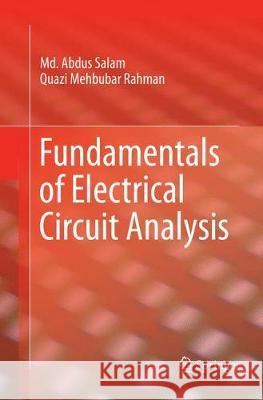Fundamentals of Electrical Circuit Analysis » książka



Fundamentals of Electrical Circuit Analysis
ISBN-13: 9789811342028 / Angielski / Miękka / 2018 / 463 str.
Fundamentals of Electrical Circuit Analysis
ISBN-13: 9789811342028 / Angielski / Miękka / 2018 / 463 str.
(netto: 439,84 VAT: 5%)
Najniższa cena z 30 dni: 443,35
ok. 22 dni roboczych
Dostawa w 2026 r.
Darmowa dostawa!
Chapter 1 Fundamental Electrical Terms
1.1 Introduction
1.2 Charge
1.3 Current
1.4 Direct and Alternating Currents
1.5 Conductors, Semiconductors and Insulators
1.6 Resistance and Conductance
1.7 Voltage
1.8 Voltage and Current Sources
1.9 Active and Passive Elements
1.10 Electric Power and Energy
1.11 Node and Loop
1.12 Measuring Equipment
1.12.1 Ammeter
1.12.2 Voltmeter
1.12.3 Ohmmeter
1.12.4 Wattmeter
1.13 Efficiency of a System
Exercise Problems
Chapter 2 Electrical Laws and Simple circuits
2.1 Introduction
2.2 Ohm’s Law
2.3 Kirchhoff’s Current Law
2.4 Kirchhoff’s Voltage Law
2.5 Series Resistors and Voltage Division Rule
2.6 Parallel Resistors and Current Division Rule
2.7 Delta-Wye Transformations
2.8 Wye-Delta Transformation
2.9 Short Circuit and Open Circuit
2.10 Source Conversion Technique
2.11 Wheatstone Bridge
Exercise Problems
Chapter 3 Different Methods for Circuit Analysis
3.1 Introduction
3.2 Method of Substitution and Cramer’s Rule
3.3 Nodal Analysis
3.4 Nodal Analysis with Dependent Source
3.5 Supernode
3.6 Mesh Analysis
3.7 Mesh Analysis with Dependent Source
3.8 Supermesh
Exercise Problems
Chapter 4 Network Theorems
4.1 Introduction
4.2 Linearity Property
4.3 Superposition Theorem with Independent and Dependent Sources
4.4 Thevenin Theorem with Independent and Dependent Sources
4.5 Norton Theorem with Independent and Dependent Sources
4.6 Maximum Power Transfer Theorem
Exercise Problems
Chapter 5 Operational Amplifiers
5.1 Introduction
5.2 The Ideal Op Amp
5.3 The Inverting Op Amp
5.4 The Noninverting Op Amp
5.5 Summing Amplifier
5.6 Difference Amplifier
5.7 Integrators and Differentiators
5.8 Interfacing
Exercise Problems
Chapter 6 Capacitors and Inductors
6.1 Introduction
6.2 Capacitors
6.3 Series and Parallel Capacitors
6.4 Energy Storage in a Capacitor
6.5 Inductors
6.6 Series and Parallel Inductors
6.7 Energy Storage in an Inductor
Exercise Problems
Chapter 7 Transients
7.1 Introduction
7.2 First Order Differential Equation
7.3 RC Circuit with and without a Source
7.4 RC Circuit with Step Response
7.5 RL Series Circuit with and without a Source
7.6 RL Circuit with Step Response
7.7 Second Order Differential Equation
7.8 RLC Series Circuit with and without a Source
7.9 Step Response of a Series RLC and a Parallel RLS Circuits
Exercise Problems
Chapter 8 Basics of AC Circuits
8.1 Introduction
8.2 Different AC Parameters
8.3 Phasors and j-operator
8.4 AC Circuit with Resistance
8.5 AC Circuit with Inductance
8.6 AC Circuit with Capacitance
8.7 Impedance and Admittance
Exercise Problems
Chapter 9 Analysis of AC Circuits
9.1 Introduction
9.2 Nodal and Mesh Analysis
8.3 Superposition Theorem
8.4 Thevenin and Norton Theorems
8.5 Instantaneous Power
8.6 Average Power and Reactive Power
8.7 Complex Power
8.8 Power Factor
8.9 Power Factor Correction
Exercise Problems
Chapter 10 Three-phase Circuits
10.1 Introduction
10.2 Wye and Delta Connections
10.3 Balanced Wye-Wye Connection
10.4 Balanced Wye-Delta Connection
10.5 Balanced Delta-Wye Connection
10.6 Balanced Delta-Delta Connection
10.7 Power in a Balanced System
10.8 Power Measurement
Exercise Problems
Chapter 11 Frequency Response
11.1 Introduction
11.2 Transfer Function
11.3 Series Resonance
11.4 Parallel Resonance
11.5 Different Filters
11.6 Bode Plots
Exercise Problems
Chapter 12 Semiconductor Diodes and Bipolar Junction Transistors
12.1 Introduction
12.2 Diode
12.3 Load-Line Analysis of Diode Circuits
12.4 Rectifier Circuits
12.5 Transistor
12.6 Load-Line Analysis of Transistor Circuits
12.7 Biasing of Transistor
12.8 Small-Signal and Large-Signal Analysis of Transistor Circuits
Exercise Problems
Chapter 13 Digital Electronics
13.1 Introduction
13.2 Number Systems
13.3 Binary Arithmetic
13.4 Basic Logic Gates
13.5 De Morgan’s Law
13.6 Boolean Algebra
Exercise Problems
Md. Abdus Salam obtained his PhD in Electrical Engineering, in 2000 from the University Teknologi Malaysia. Currently, he is working as a Faculty member in the Department of Electrical and Electronic Engineering, Faculty of Engineering at the Universiti Teknologi Brunei, Negara Brunei Darussalam. His research interests include power system modelling for on-line control, insulator pollution studies, grounding systems and renewable energy. He has published a large number of referred journal and conference papers. He is a senior member of IEEE, member of IET and working as a reviewer of IEEE Transactions on Power Delivery, IEEE Transactions on Dielectrics and Electrical Insulation, IET Generation, Transmission and Distribution, Journal of Electrostatics, Elsevier Science etc.
Quazi M. Rahman obtained his PhD degree from the University of Calgary, Canada in 2002. Currently, he is serving as a faculty member in the Department of Electrical and Computer Engineering, at the University of Western Ontario, London, Canada. He is a licensed professional engineer in the province of Ontario, Canada and a senior member of the IEEE. He is a contributing author of a number of refereed journals, proceeding papers, and book chapters in the areas of wireless communications, and power systems engineering.
This book is designed as an introductory course for undergraduate students, in Electrical and Electronic, Mechanical, Mechatronics, Chemical and Petroleum engineering, who need fundamental knowledge of electrical circuits. Worked out examples have been presented after discussing each theory. Practice problems have also been included to enrich the learning experience of the students and professionals. PSpice and Multisim software packages have been included for simulation of different electrical circuit parameters. A number of exercise problems have been included in the book to aid faculty members.
1997-2025 DolnySlask.com Agencja Internetowa
KrainaKsiazek.PL - Księgarnia Internetowa









